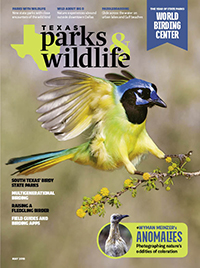
Skills: What's That Bird?
Field guides and apps enrich any birder's outing, no matter the skill level.
By Julia Gregory and Kiki Corry
Birding’s a blast, but it can be a little frustrating to see a lovely bird and not be able to identify it. Luckily, that’s a fixable problem — just buy a field guide or download an app, right? Wait a minute, there are so many to choose from. Help?
What is the best guide?
The easy answer: The best guide is the one that works for you. Whether on printed page or digital screen, guides that help us narrow down likely birds by range, include bird calls and compare similar birds are the most helpful. Even expert birders rely on these fine comparisons, especially as they complete their own “life list” of birds they’ve seen.
GETTING FAMILIAR:
Guides vary a bit. They all contain similar information, but organization is a key element for ease of use. Flip through the book (or app) quickly. The information you see might contain lots of birds that aren’t even in your area. That can prove unnecessarily confusing, especially for beginners. Perhaps there’s a regional guide that’s more pertinent for you.
Take a close look at imagery. Drawings or photographs need to be clear; coloration really aids in faster identification. Males and females, juveniles and adults, breeding or normal plumage — all these factors can dramatically change a bird’s looks. Does your guide provide these images as well?
Familiarize yourself with habitat/migration maps and diagrams, as well as how species are organized into chapters. Don’t try to memorize it, just remember where to find it. If there is a “how to use this book” section, take a moment to read it.
START WITH WHAT YOU KNOW:
Look up a bird you can identify already by using the index. Find the picture as well as the description and range map. Is everything clustered together, or did you have to find bits and pieces here and there?
Next, check out the birds you regularly see but can’t identify by name. Notice their silhouettes, colors, body shapes and feather patterns. Compare sizes and take note of behaviors; pay attention to very specific details of plumage called field marks. Now look up those local birds in your guide. What bird features were most helpful to identify the birds?
You can use your guide as a study tool when you’re back home relaxing. Flip through your guide or app and look for birds you think you saw. Look at the pictures, check the range maps, look for cues on behavior and calls, and read the appendices. If you are not familiar with bird anatomy, study the diagrams and learn the terms. Gradually you will build your vocabulary and train your eye to pick out and remember the pertinent details.
SHARPEN YOUR OBSERVATIONS:
Study all the birds you observe, guide or no guide. The sooner you get to your bird guide, the easier it will be to remember all the details. You may find yourself carrying your guide everywhere now — what a fun way to learn more!
Every time you turn to your guide or app, you learn more about using it. The more often you go from bird to guide and from guide to bird, the better and faster you will get.
Related stories

